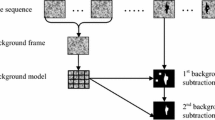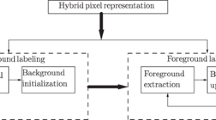Abstract
Foreground objects can be extracted effectively by subtracting the background in the image frames, provided that an updated model of the background is available at any time. This is achieved by initialization (also called bootstrapping) of the background followed by its maintenance. In this paper, a patch-based technique for robust background initialization has been proposed, that overcomes the sleeping person problem. The proposed technique is able to cope with heavy clutter, i.e, foreground objects that stand still for a considerable portion of time. The method rests on sound principles in all its stages and only few, intelligible parameters are needed. Experimental results shows that the proposed algorithm is effective.
Access this chapter
Tax calculation will be finalised at checkout
Purchases are for personal use only
Similar content being viewed by others
References
Colombari, A., Fusiello, A.: Patch-based background initialization in heavily cluttered video. IEEE Trans. Image Process. Intell. (2010)
Farin, D., deWith, P.H.N., Effelsberg, W.: Robust background estimation for complex video sequences. In: Proceedings of IEEE International Conference on Image Processing, vol. 1, pp. 145–148 (2003)
Shi, J., Malik, J.: Normalized cuts and image segmentation. IEEE Trans. Pattern Anal. Mach. Intell. 22(8), 888–905 (2000)
Jain, A.K., Murty, M.N., Flynn, P.J.: Data clustering: a review. ACM Comput. Surv. 31(3), 264–323 (1999)
Colombari, A., Fusiello, A., Murino, V.: Background initialization in cluttered sequences. Presented at the 5th Workshop on Perceptual Organization in Computer Vision, in conjunction with CVPR 2006 (2006)
Nunes, P., Correia, P., Pereira, F.: Coding video objects with the emerging mpeg-4 standard. Presented at the I Conferência Nacional de Telecomunicações, Apr 1997
Porikli, F., Tuzel, O.: Human body tracking by adaptive background models and mean-shift analysis. In: IEEE International Workshop on Performance Evaluation of Tracking and Surveillance (2003)
Javed, O., Shah, M.: Tracking and object classification for automated surveillance. Lecture Notes in Computer Science, vol. 2353, pp. 439–443 (2006)
Lv, F., Nevatia, R.: Single view human action recognition using key pose matching and Viterbi path searching. In: IEEE Conference on Computer Vision and Pattern Recognition, pp. 1–8 (2007)
Author information
Authors and Affiliations
Corresponding author
Editor information
Editors and Affiliations
Rights and permissions
Copyright information
© 2020 Springer Nature Switzerland AG
About this paper
Cite this paper
Karl Marx, L.R., Veluchamy, S. (2020). Foreground Detection Scheme Using Patch Based Techniques for Heavily Cluttered Video. In: Auer, M., Ram B., K. (eds) Cyber-physical Systems and Digital Twins. REV2019 2019. Lecture Notes in Networks and Systems, vol 80. Springer, Cham. https://doi.org/10.1007/978-3-030-23162-0_75
Download citation
DOI: https://doi.org/10.1007/978-3-030-23162-0_75
Published:
Publisher Name: Springer, Cham
Print ISBN: 978-3-030-23161-3
Online ISBN: 978-3-030-23162-0
eBook Packages: Intelligent Technologies and RoboticsIntelligent Technologies and Robotics (R0)




